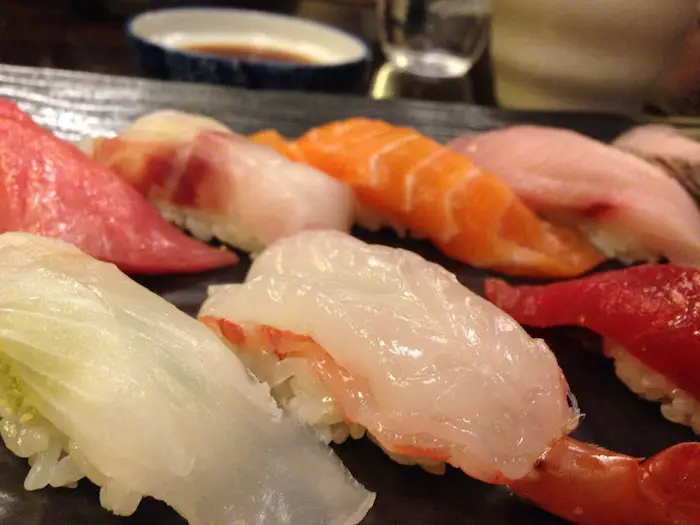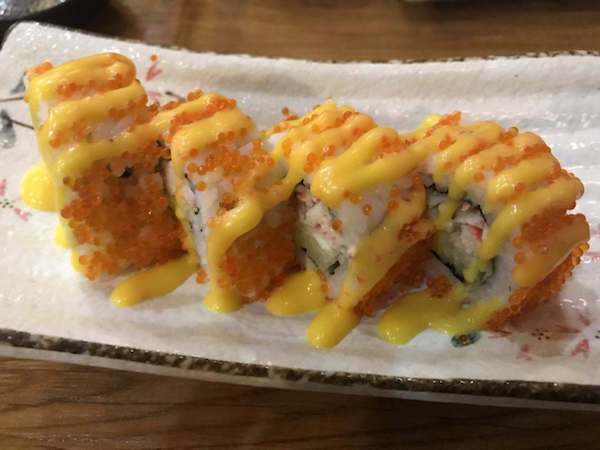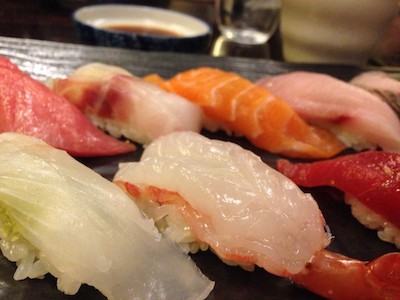We are reader supported. When you purchase through links on our site, we may earn an affiliate commission. Also, as an Amazon affiliate, we earn from qualifying purchases.

People who are new to sushi culture are often surrounded by a lot of misconceptions regarding this traditional Japanese cuisine. Most of these misconceptions arise from what people see and hear, and they derive conclusions and assumptions based on that.
Many people often ask me ‘Is sushi raw fish’ and the answer to that is No. The dish that includes only raw fish slices is called sashimi. Sushi comprises of fish or seafood with seasoned rice, vegetables, and nori sheet. So, sushi is not just one item but a combination of a few ingredients balanced together to bring out an amazing flavor.
While the dish originated with raw fish preserved in fermented rice, sushi has highly evolved from what it used to be hundreds of years ago. The modern sushi of today not only comprise of raw meat, but also cooked fish and seafood (grilled, deep-fried, steamed, and baked).
Those who are not comfortable with eating raw or cooked meat also have delicious options to savor. So, you don’t have to be a meat-eater to be able to enjoy sushi. There are numerous tasty vegetables and fruit options to choose from, and examples are sweet potato, cucumbers, carrots, avocado, mango, strawberry, and so on.
To get a better understanding of the concept, let’s take a closer look at the difference between sashimi and sushi.
Difference Between Sashimi And Sushi

Sashimi is the sliced raw fish that may be dipped in soy sauce and often served as a side dish with sushi. Usually, the freshest fish and best catch of the day is used for preparing sashimi, and it is meant to be eaten with chopsticks. It is typically served with pickled ginger and wasabi paste.
Sushi means ‘sour’ and it is used for any type of dish that comprises of vinegared rice and served with other toppings. It may be served with various types of fish, seafood, vegetables, and fruits. The dish may have just one ingredient or a combination of two or more.
The tradition of eating fish with rice comes from the primary food staple of the location from where ‘sushi’ originated. As a wide variety of raw fish is used for making sushi, people often have the misconception that sushi means raw fish, but this is not true.
For more information: Difference Between Nigiri, Sashimi, Sushi Roll, Hand Roll, Gunkan Sushi
Traditional Sushi Rolls vs American Sushi Rolls
If you are a sushi fan who has mostly eaten at westernized restaurants only, you will be surprised to see the type of sushi served in Japan. The most basic and traditional maki rolls will comprise of only cucumber as the main filling, or they may have a combination of cucumber and watermelons.
Most of the sushi rolls served at Japanese restaurants will have just one ingredient and the dish is not made fancy with sauces and other condiments. You will rarely find any specialty rolls or inside-out roll varieties in Japan.
The westernized or better known as American sushi roll can be best described as the traditional cuisine adapted to cater to foreign tastes. As eating raw fish was a completely alien concept in the western countries, the pioneer chefs had to offer cooked options and hide the nori sheet to appeal to the masses.
The American sushi rolls have highly evolved from what they used to be and today you can find a wide range of cooked fish and seafood options such as cooked imitation crab in California roll, fully cooked clam, fried shrimps in shrimp tempura roll, fully cooked clam, grilled squid and octopus.
The specialty rolls may contain vegetables and fruits along with cooked, fried and battered seafood varieties. Another aspect of American sushi rolls is that they are slathered in sauces, something you will not find in the traditional Japanese sushi rolls.
Reasons Why People Believe Sushi Is Raw Fish
Although sushi has come far from what it used to be centuries ago, people still relate the dish to raw fish and it’s not uncommon to find people asking ‘is sushi raw fish’. The reason lies deep in the roots and origin of sushi in ancient times when farmers used rice to ferment raw fish.
The term sushi is derived from an old grammatical form which meant ‘sour’ but the form is no longer used. Sour typically described the ancient method of making sushi by fermenting fish and seafood in salted rice. When the time was right, the fish part was eaten and rice was discarded.
The vinegar formed by fermenting rice helped in breaking down the fish into amino acids and also produced a strong umami flavor. This helped in preserving fish and seafood for months, a useful method to store food before the invention of refrigerators and iceboxes.
As the modern methods of making sushi evolved, vinegar was invented to aid in fermenting and preserving food. They started adding vinegar to rice around the Muromachi period and this helped in souring rice quickly and improving the flavor too. This ultimately led to the fermentation process without the rice going bad.
Some centuries later, osaka and sushi came together to become oshi-zushi, a type of sushi when rice and seafood are pressed into molds. This led to the formation of sushi as created by chef Hanaya Yohei in the 19th century. This is the most common form that comes to the mind when we hear sushi. It can be prepared quickly and also eaten with just one hand, making it one of the initial forms of fast food.
As sushi became popular and reached different parts of the world, chefs started experimenting with different vegetables and fruits in the place of raw fish. Many cooked seafood options and other meat (chicken, beef, horse) were also introduced to cater to different tastes. Now, that we know sushi is not just raw fish, let’s take a look at the different vegetarian and cooked sushi options.
Vegan And Vegetarian Sushi Options
I know many people who think sushi means non-vegetarian food and stay away from it. Thankfully, there are many vegan and vegetarian options available for a delicious and filling meal. You can also try the easy to make vegetable sushi rolls at home to make delicious snacks for all.
#1. Kappa Maki
Also known as the cucumber roll in English, this is easy to make and delicious sushi roll for vegan and vegetarians. It includes slices of de-seeded cucumber wrapped in a thin sheet of seasoned rice and seaweed. It serves as a great starter and an amazing cleanser for the regular sushi diners. You can find Kappa Maki at restaurants and supermarket shelves.
#2. Shinko Maki
Another traditional vegetarian sushi, shinko is a generic term used to denote pickled vegetables in Japan. Takuan, for example, is the pickled radish and it is brown or bright yellow in color. It has a tangy taste and crunchy texture. While the westerners may not be a great fan of pickled vegetables, this is considered as a refreshing sushi option in Japan.
#3. Kanpyo Maki
Kanpyo, or dried gourd strips is a popular vegetarian filling used in traditional sushi rolls and it is known to aid in digestion. Hence, it is usually ordered at the end of a heavy meal. The dried gourd strips are hydrated in water before using it in sushi. Some chefs prefer to use the pickled version of kanpyo and its flavor is similar to sweet soy sauce.
#4. Ume, Cucumber Shiso Makizushi
If you are looking for a combination of vegetarian flavors then try out this Japanese pickled plum with shiso leaves and sweet cucumber. This is a staple vegan sushi roll that can serve as a concluding meal or a palate cleanser in the middle.
#5. Natto Temaki
Temaki is the Japanese term for handroll and natto is the name for fermented soybeans, a traditional delicacy that has a sticky texture. Although a bit messy to eat, natto is a highly popular food for its numerous health benefits. If you have not eaten natto before, it may take you some time to get used to it as the food has an acquired taste. Natto temaki comprises of the fermented soybeans wrapped in seasoned sushi rice and nori seaweed.
#6. Tamagoyaki Nigiri
Many people who think sushi is raw fish find it difficult to believe that eggs can also go with sushi, but they do. Tamagoyaki is the Japanese name for a slightly sweet omelet that has a fluffy texture. It is one of the most popular items in Japanese cuisine. Tamagoyaki nigiri comprises of a rice mold with a slice of tamagoyaki on the top.
Cooked Sushi Options
The reason why I prefer cooked sushi rolls over raw fish or seafood options is that there is no risk of food poisoning. You don’t have to worry about freezing raw fish or meat at a specific temperature to avoid bacterial contamination. Cooked sushi can also be stored in the refrigerator for long as they have a higher shelf life. Even if the sushi rice becomes hard or the nori turns soggy, you can still enjoy the cooked filling that does not go bad.
#1. California Sushi Roll

When talking about cooked sushi options, the California rolls stand on the top of the chart. Although not a traditional sushi form, it has become a much sought after choice you can find in the menu of Japanese sushi restaurants. It comprises of imitation crabsticks, avocado, and cucumber as filling to make a delicious meal.
#2. New York Sushi Roll
If you are a seafood enthusiast then you must try this sushi roll that comprises of boiled farm-raised shrimps combined with cucumber and avocado. In some recipes, the chef may marinate the shrimps or grill them with seasonings to further enhance the taste of this Japanese delicacy.
#3. Smoked Sushi Roll
If you like salmon and wish to enjoy it in a beautifully wrapped roll but don’t like the taste of raw fish, order smoked salmon roll instead. When the chef partially cooks the salmon, the smoked version not only tastes great but also costs less than the raw fish. You can buy the smoked salmon at grocery stores and prepare your own sushi roll at home.
#4. Spicy Crab Sushi Roll
If you are a sushi beginner who doesn’t appreciate the taste of raw fish, please your tastebuds with the spicy crab sushi roll. This is a mouthwatering inside-out sushi roll that comprises of spicy crab salad as the main filling. The chef usually cooks the crab meat and then shreds it to make a salad. The shredded crab meat is then mixed with mayonnaise, sriracha sauce, and masago.
#5. Chicken Katsu Roll Sushi
If you thought sushi was all about fish and seafood only then this will prove to be an eye-opener for you. This is an inside-out roll that comprises of crispy breaded chicken pieces as the main ingredient. The roll is then drizzled with delicious mayo and eel sauce for that tangy taste. Chicken lovers who wish to enjoy sushi without raw or cooked fish/ seafood options will love this combination.
I have created an article that talks about the best-cooked sushi options to order in a restaurant for beginners, so check it out.
Related Questions
Is sushi served cold at grocery stores?
One of the reasons why sushi is associated with raw fish in the western world is the fact that the toppings are usually served cold. As sushi is meant to be eaten immediately and the quality starts deteriorating with time, it is usually stored inside the refrigerator.
What type of raw fish is used in making sushi?
When using raw fish or seafood in making sushi, the chef always uses the sushi-grade variety to prevent any food-borne diseases. Sushi-grade means the fish is gutted and bled soon after it is caught and then the fish is stored at low temperature to preserve the flesh. Bacteria cannot thrive at very low temperatures, hence the food is safe for consumption.
What is the best type of sushi to make at home?
While it’s possible to make sushi containing raw fish at home, I recommend trying the cooked varieties or veggies options at home. The reason is simple. With raw fish and seafood, comes a lot of handling issues and you need to be careful about not leaving it outside at room temperature by mistake. With cooked options and veggies, there are no such problems so you can cook stress-free.
See Also:
Can You Use Yakisoba Noodles for Ramen?
Do Ramen Shops in Japan Use MSG?
4 Best Japanese Cast Iron Pans to Buy
9 Best Japanese Knife Sets to Buy
Can You Make Sushi with Supermarket Fish?

